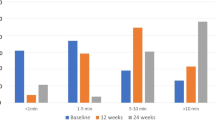Abstract
INTRODUCTION: Patients with end-stage fecal incontinence, in whom all standard medical and surgical treatment has failed or is not expected to be effective, can be treated by stimulated graciloplasty. The aim of the present study was to assess the efficacy of stimulated graciloplasty by both direct nerve and intramuscular perineural stimulation techniques and to evaluate various parameters relative to outcome. METHODS: A prospective analysis of all patients who underwent this procedure was undertaken. All patients were preoperatively investigated by anal manometry, electromyography, pudendal nerve terminal motor latency assessment, endoanal ultrasound, and an enema retention test. They were further assessed with an incontinence scoring system and a Quality of Life Questionnaire. Postoperative evaluation included anorectal manometry, incontinence score registry, and a Quality of Life Questionnaire. In our initial experience the stimulation system electrodes were fixed directly to the nerve (direct nerve stimulation graciloplasty); later in the study the stimulation system electrodes were fixed intramuscularly close to the nerve branches (intramuscular perineural stimulation graciloplasty). RESULTS: From May 1993 to February 1998, 27 patients underwent 33 gracilis transpositions for fecal incontinence, 30 of which were stimulated. Six of the patients with direct nerve stimulation graciloplasty eventually had the direct nerve stimulator removed and replaced with an intramuscular electrode stimulator. After an mean follow-up (until the time of exit from study) of 12.5 (range, 1–23) months for direct nerve stimulation graciloplasty and 21 (range, 8–27) months for intramuscular perineural stimulation graciloplasty, 13 graciloplasties (43 percent) were successful. There was no correlation between outcome of surgery and age, duration or cause of symptoms, body habitus, manometric or electromyographic parameters, prior sphincter repair, the presence of a pre-existing stoma, or any immediate postoperative complications. However, the number of patients with intramuscular perineural stimulation graciloplasty who had a successful outcome (continent, 69 percent; improved but not fully continent, 23 percent; incontinent, 8 percent) was significantly higher than patients with direct nerve stimulation graciloplasty (improved but not fully continent, 10 percent; incontinent, 90 percent). CONCLUSION: The success of stimulated graciloplasty is dependent on the method of nerve stimulation, whereas surprisingly, none of the many other factors assessed influenced outcome.
Similar content being viewed by others
References
Brockelhurst JC. Management of anal incontinence. Clin Gastroenterol 1975;4:487–97.
Nelson R, Norton N, Cautley E, Furner S. Community based prevalence of anal incontinence. JAMA 1995;274:559–61.
Korsgen S, Keighley MR. Stimulated gracilis neosphincter—not as good as previously thought: report of four cases. Dis Colon Rectum 1995;38:1331–3.
Baeten CG, Konsten J, Spaans F,et al. Dynamic graciloplasty for treatment of faecal incontinence. Lancet 1991;338:1163–5.
Baeten CG, Geerdes BP, Adang EM,et al. Anal dynamic graciloplasty treatment of intractable fecal incontinence. New Engl J Med 1995;332:1600–5.
Jorge M, Wexner SD. Anorectal manometry: techniques and clinical applications. South Med J 1993;86:924–31.
Vaccaro CA, Wexner SD, Teoh T-A, Choi SK, Cheong DM, Salanga VD. Pudendal neuropathy is not related to physiologic pelvic outlet obstruction. Dis Colon Rectum 1995;38:630–4.
Browning GG, Parks AG. Postanal repair for neuropathic fecal incontinence. Br J Surg 1983;70:101–4.
Jorge JM, Wexner SD. Etiology and management of fecal incontinence. Dis Colon Rectum 1993;36:77–97.
Williams NS, Patel J, George BD, Hallan RI, Watkins ES. Development of an electrically stimulated neoanal sphincter. Lancet 1991;338:1166–9.
Wexner SD, Gonzalez AP, Teoh TA, Moon H. The stimulated gracilis neosphincter for fecal incontinence: a new use for an old concept. Plast Reconstr Surg 1996;98:693–9.
Geerdes BP, Kurvers HA, Konsten J, Heineman E, Baeten CG. Assessment of ischemia of the distal part of the gracilis muscle during transposition for anal dynamic graciloplasty. Br J Surg 1997;84:1127–9.
Geerdes BP, Heineman E, Freling G, Keizer HA, Woloszko J, Baeten CG. Vascular and stimulation delays in dynamic musculoplasty. Surgery 1997;121:402–10.
Wexner SD, Gonzalez-Padron A, Rius J,et al. Stimulated gracilis neosphincter operation: initial experience, pitfalls, and complications. Dis Colon Rectum 1996;39:957–64.
Mander BJ, Williams NS. Patient selection is integral to the success of the electrically stimulated gracilis neosphincter [letter]. Dis Colon Rectum. 1996;39:712.
Rongen MJ, Baeten CG. Treatment of fecal incontinence by means of dynamic graciloplasty. Semin Colon Rectal Surg 1997;8:110–5.
Author information
Authors and Affiliations
Additional information
Supported in part by educational grants from NICE Technology, Inc. of Ft. Lauderdale, Florida and Medtronic, Inc. of Minneapolis, Minnesota. Dr. Mavrantonis was supported in part by a grant from the Onassis Educational Foundation.
Read at the meeting of the American Society of Colon and Rectal Surgeons, San Antonio, Texas, May 2 to 7, 1998.
About this article
Cite this article
Mavrantonis, C., Wexner, S.D. Stimulated graciloplasty for treatment of intractable fecal incontinence. Dis Colon Rectum 42, 497–504 (1999). https://doi.org/10.1007/BF02234176
Issue Date:
DOI: https://doi.org/10.1007/BF02234176




